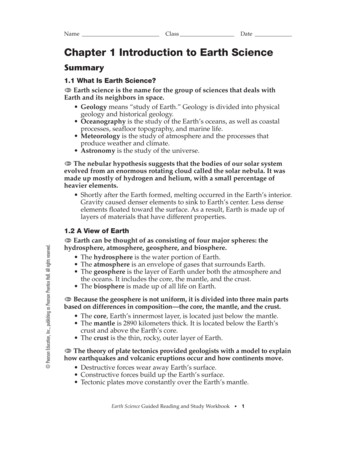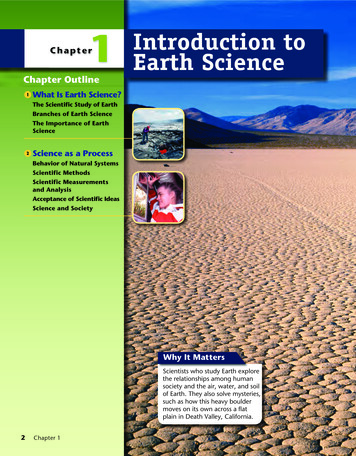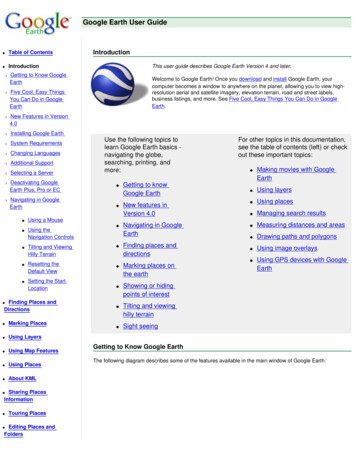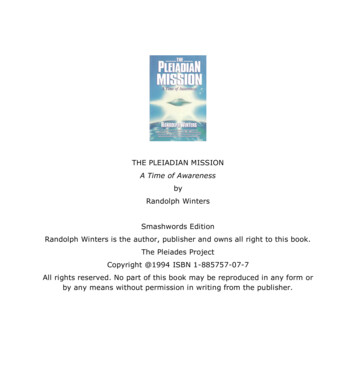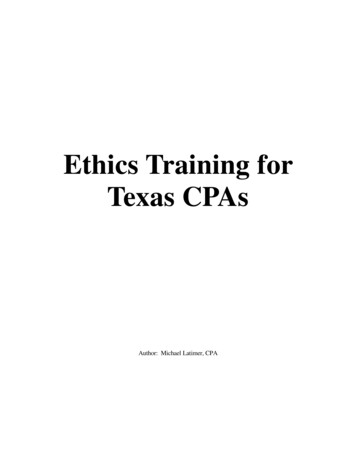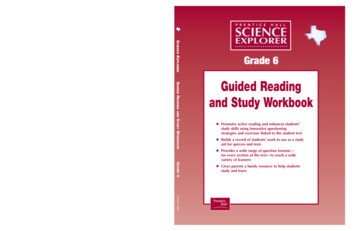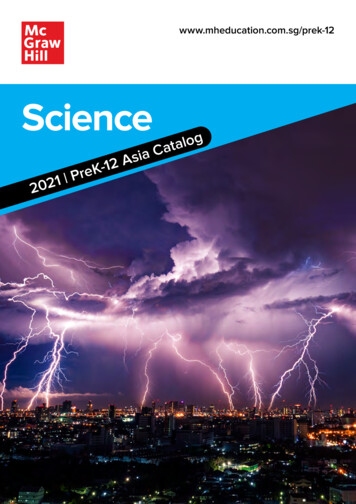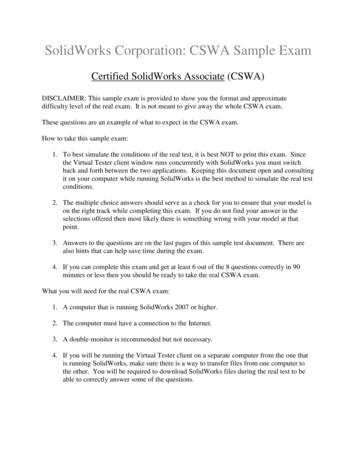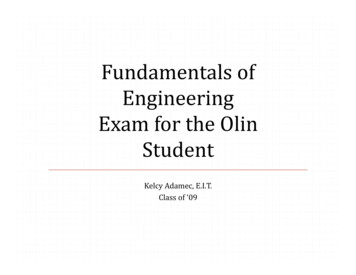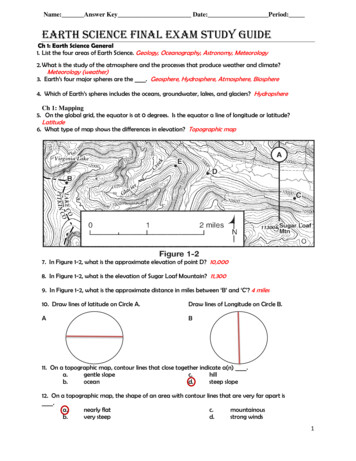
Transcription
Name: Answer Key Date: Period:Earth Science Final Exam Study GuideCh 1: Earth Science General1. List the four areas of Earth Science. Geology, Oceanography, Astronomy, Meteorology2. What is the study of the atmosphere and the processes that produce weather and climate?Meteorology (weather)3. Earth’s four major spheres are the . Geosphere, Hydrosphere, Atmosphere, Biosphere4. Which of Earth’s spheres includes the oceans, groundwater, lakes, and glaciers? HydropshereCh 1: Mapping5. On the global grid, the equator is at 0 degrees. Is the equator a line of longitude or latitude?Latitude6. What type of map shows the differences in elevation? Topographic map7. In Figure 1-2, what is the approximate elevation of point D? 10,0008. In Figure 1-2, what is the elevation of Sugar Loaf Mountain? 11,3009. In Figure 1-2, what is the approximate distance in miles between ‘B’ and ‘C’? 4 miles10. Draw lines of latitude on Circle A.Draw lines of Longitude on Circle B.AB11. On a topographic map, contour lines that close together indicate a(n) .a.gentle slopec.hillb.oceand.steep slope12. On a topographic map, the shape of an area with contour lines that are very far apart is.a.nearly flatc.mountainousb.very steepd.strong winds1
Ch 3: Rocks13. Define Rock. A mixture of minerals14.-17. Complete the table.Type of RockDefinitionCharacteristicsIgneousA rock formed from magma or lava when it coolsand crystallizes.Random crystals, coarse-grainedor fine-grained.MetamorphicA rock formed by a rock deep in earth under heatand pressure.Dense, foliated or nonfoliatedSedimentaryA rock formed from weathered products fromrocks that have been transported, deposited,compacted and cemented.Layers, fossils, brittle, mud cracks,ripple marks.18. How is a sedimentary rock formed? A rock formed from weathered products from rocks that havebeen transported, deposited, compacted and cemented.19. A rock that forms from cooling lava is classified as an . Extrusive igneous20. What processes form metamorphic rocks? Heat and pressureCh 5: Weathering21. What type of weathering occurs when physical forces break rock into smaller pieces withoutchanging the rock’s chemical composition is called . Mechanical weathering22. When water freezes, its volume . increases23. Which of the following is the result of chemical weathering?a.a rock that has been changed into one or more new compoundsb.a rock that has been broken into tiny piecesc.a rock that has been split in two24. Whenever the characteristics and chemical composition of weathered materials have been altered,they have undergone what type of weathering? Chemical weathering25. List 3 factors that affect the rate of weathering in rocks?Climate, rock characteristics, and exposed surface area of rock26. Chemical weathering would be .a.most effective in a warm, dry climateb.most effective in a cold, dry climatec.most effective in a warm, humid climated.equally effective in any climateCh 6: Running Water and Ground Water27. What is the main factor on how much erosion a river will create?It’s velocity or speed of the water moving down the river28. Compare a young to a mature river and list features found in both.Young fast moving, high erosion, water falls, steep gradient, V-shape valleysMature slower moving, less erosion, meanders, ox bow lakes, gentle gradient, U-shape valleys,flood plains2
29. In Figure 6-2, what letter labels the zone of saturation? D30. What feature is labeled C in Figure 6-2? Water table31. In Figure 6-2, which of the wells shown will NOT be able to pump water? F32. Groundwater is found underground in the zone of . Aeration33. The ability of a stream to erode and transport material depends largely on its . Velocity34. If a river’s gradient because becomes less steep, what will happen to the velocity of the river? Slowdown35. The flat portion of a valley floor adjacent to a stream channel is called a . Flood plain36. A loop-like bend in the course of a stream is called a(n) . meander37. What process is illustrated by the arrows labeled A in Figure 6-1? precipitation38. In Figure 6-1, what process is illustrated by the arrows labeled D? infiltration39. What is the energy source for the water cycle shown in Figure 6-1? Sun40. The water cycle is the . Water constantly moves among the oceans, the atmosphere, the solidearth, and the biosphere. This unending circulation of Earth’s water supply is the water cycle.3
Ch 7: Glaciers41-44. Identify the features labeled in figure 7-1. A drumlins, B E end moraine, C esker, D kame,E ground moraine, F Kettles, G outwash plainCh 8: Earthquakes45. A zone of weakness or a break in Earth’s crust is known as what? Fault46. Where do most present-day faults occur? Plate boundaries47. A tectonic plate boundary where colliding plates slide past each other (such as the San Andreasfault in California) is an example of: transform fault48. What is the minimum number of seismograph stations from which scientists must collect data tolocate the epicenter of an earthquake? 349. What is the difference between the Focus and Epicenter? Focus is the first initial movement belowground, the epicenter is directly above the focus on the surface.50. A tsunami is typically caused when? An earthquake on the ocean floor with the ocean floorthrusting upwards.51. The Mexico City earthquake caused much damage because many structures were built on an oldsandy lake bed. When the earthquake struck, many foundations settled unevenly or sank into theground causing the buildings to collapse. What type of seismic wave did most of the damage?Surface wave52. P-waves from a seismic event can be detected on the other side of the globe, but S-waves from thesame disturbance cannot be detected on the other side of the globe. This indicates to geologiststhat.a. S-waves are slower than P-wavesb. the continents are drifting apartc. the middle of Earth is liquidd. the earthquake causing the waves was especially severe.53. The largest earthquake ever recorded was in Chile. Using the Richter scale this number would beclose to what? 1054. Thousands of earthquakes take place every day. Most earthquakesa. kill large numbers of peoplec. kill few but cause much damageb. occur in Californiad. can’t even be felt by peopleCh 9: Plate Tectonics4
55. What causes the tectonic plates of earth to move? Convection forces in the mantle56. The Atlantic Ocean is growing larger. How does paleomagnetism proves this? Same age samepolarity in the rocks are found the same distance from the middle ridge, with youngest rocks foundcloser to the middle and older rocks found closer to shore.57. What forms when one oceanic plate is forced beneath another plate? A subduction zone, a trench,and a volcanic island arc will form.58. Why is coal, which comes from life that died a long time ago found in parts of Illinois?a. Illinois once had a tropical climate (warm, humid)b. Illinois once had an arctic climatec. Illinois is located on a subduction zoned. Illinois is located near a large body of water59. List the evidences for Wegener’s Continental Drift hypothesis? Same rocks & fossils found ondifferent continents, continents fit like puzzle pieces, glacial streak marks in Africa and Australia.60. What type of boundary occurs where two plates move together, causing one plate to descend intothe mantle beneath the other plate? Convergent boundary66. In Figure 1-1, Identify each letter. A crust, B upper mantle,C lower mantle, D Outer core, E Inner core. A B lithosphere67. What are the three main parts of the geosphere?Crust, mantle, coreCh 10: VolcanoesList 3 factors that helps determine whether a volcanic eruption will be violent or quiet.Amount of dissolved gases, temperature, and amount of silica (composition)68. Highly explosive volcanoes tend to have what type of magma?a. magma with high silica, high viscosity, and higher gas contentb. magma with low silica, low viscosity, and lower gas contentc. magma with low silica, high viscosity, and lower gas contentd. magma with no silica, high viscosity, and no gas content70. The broad, slightly dome-shaped volcanoes of Hawaii are what type of volcanoes?Shield volcano71. A volcano that is fairly symmetrical and has both layers of lava and pyroclastic deposits is a .Composite (Stratovolcano) volcano72. What is a caldera? A large depression in a volcano73. The volcanic features formed at divergent ocean plate boundaries are .a. oceanic ridgesc. continental volcanic arcsb. volcanic island arcsd. ocean trenches5
74. What type of plate boundary resulted in the volcanic activity illustrated in Figure 10-2?Ocean – continental convergent plate boundary.75. Which type of landform develops at plate boundaries where one oceanic plate descends beneathanother oceanic plate? Volcanic island arc76. The largest intrusive igneous body is called a . batholith77. What is true about all plutons?a. They form above Earth’s surface.b. They form near Earth’s surface.c. They form below Earth’s surface.d. They cut across other rock layers.78. What commonly horizontal intrusive igneous body is formed when magma is injected parallel tosedimentary bedding planes? Sill79. Contrast a batholith to a laccolith Batholith is big intrusive igneous rock from the magma chamberand a laccolith is when magma is injected between sedimentary layers with a bulge.80. Contrast a dike to a sill A dike is vertical rock formation and a sill is horizontal rock formation.79. What feature is labeled D in Figure 10-1? Crater or Vent80. What feature is labeled A in Figure 10-1? pipe81. What type of volcano is illustrated in Figure 10-1? Composite volcanoMinerals82. Define mineral. is natural occurring, inorganic solid with orderly crystalline structure and adefinite chemical composition.83. Why is color not often a useful property in identifying minerals? Same mineral can have differentcolors84. Identify all properties of a mineral and define each. Color, Streak color in powder form, luster describe how light reflects from the surface, hardness how well it can be scratched, cleavage the tendency to break along flat even surfaces, Density mass / volume6
A subduction zone, a trench, and a volcanic island arc will form. 58. Why is coal, which comes from life that died a long time ago found in parts of Illinois? a. Illinois once had a tropical climate (warm, humid) b. Illinois once had an arctic climate c. Illinois is located on a subduction zone
